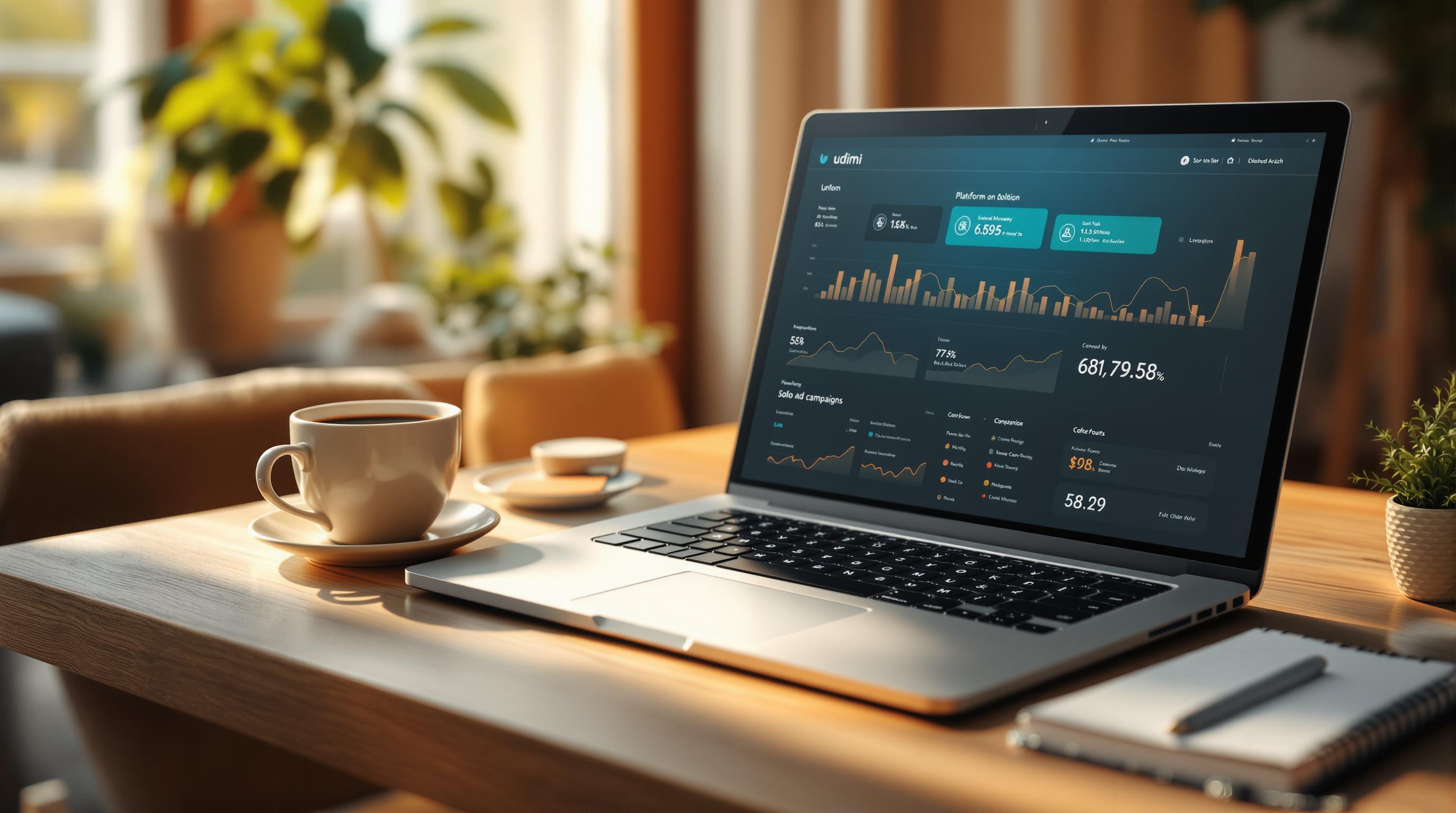Solo ads rely on three key metrics to measure success: opens, clicks, and sales. These metrics form a funnel, where each stage builds on the previous one:
- Open Rates: Measure how many recipients open your email. Influenced by factors like subject lines, sender reputation, and timing.
- Click Rates: Track how many people click on links in your email. Strong CTAs and mobile optimization improve this.
- Sales: The ultimate goal - converting clicks into purchases. Optimized landing pages and urgency tactics can help.
Improving these metrics requires a combination of tracking tools (like UTM parameters), heatmaps, and A/B testing. Focus on fixing bottlenecks, such as low click rates or poor conversions, to maximize ROI. By regularly analyzing and optimizing these metrics, you can enhance the performance of your solo ad campaigns.
Measuring Success: Key Metrics For Analyzing Solo Ad Performance
3 Key Solo Ad Metrics
Building on the funnel concept, these three metrics help pinpoint where improvements are needed at different stages of the customer journey.
Email Open Rates
Email open rates show how many recipients actually open your message. To calculate, divide the number of unique opens by the number of delivered emails, then multiply by 100%. While typical email marketing open rates fall between 15-25%, solo ads often perform better because of their targeted nature[2].
Several factors influence open rates:
- Sender reputation: A trusted sender name encourages more opens.
- Subject lines: Eye-catching subject lines grab attention.
- Timing: Sending emails at the right time for your audience increases visibility.
- List quality: A well-maintained, engaged email list performs better.
Click Rates
Click-through rates (CTR) reveal how effective your email content and call-to-action are. Solo ads typically outperform standard email campaigns, which average a 2.6% CTR[2]. Most solo ads see CTRs between 2-5%, with top campaigns hitting 10-20%[8][4].
| Performance Level | Click-Through Rate | Typical Scenario |
|---|---|---|
| Average | 2-5% | Baseline performance |
| Good | 5-10% | Strong content or offer |
| Excellent | 10-20% | Highly targeted campaigns |
Sales and Conversion Numbers
Sales conversions are the ultimate measure of success. A good conversion rate is often between 1-3%, though this varies depending on the industry and offer type[7][2]. Tools like ClickMagick or Voluum are commonly used to track these metrics accurately[8].
Analyzing these metrics can highlight areas to improve. For example, high open rates but low clicks might mean your subject lines are strong, but the email content needs work. On the other hand, high clicks but low sales could signal an issue with your landing page.
sbb-itb-aaea31d
How to Improve Each Metric
Getting More Email Opens
Timing and personalization are key to improving open rates. Studies suggest that emails sent on Tuesdays between 10 AM and 2 PM tend to perform better[2]. Pair this timing with personalized subject lines, which can boost open rates by as much as 50%[1].
Building a strong sender reputation is also essential. Use email authentication protocols like SPF, DKIM, and DMARC to improve deliverability, potentially increasing open rates by 10%[1]. Maintaining a consistent sending schedule further helps establish trust with email providers.
Don’t overlook the preheader text - it acts as a preview for your email and can increase open rates by 7-10%[2]. Instead of repeating your subject line, make the preheader add something extra. For example, if your subject line is "Limited Time Offer", your preheader could say, "Save 50% on Premium Templates Until Midnight."
Once you’ve increased your open rates, the next step is turning that attention into action.
Increasing Click Rates
With 81% of emails being opened on mobile devices[9], optimizing your email for mobile is a must. Ensure your design adapts seamlessly to different screen sizes - this can boost click-through rates by 15%[8].
Your call-to-action (CTA) plays a huge role in getting clicks. Avoid generic phrases like "Click Here." Instead, use action-focused language that highlights the benefit. For example, "Claim Your Free Trial Now" can increase click-through rates by up to 28%[3].
Improving click rates is only part of the equation. What happens after the click is just as important.
Converting More Sales
To turn clicks into sales, your landing pages need to perform. Page load speed is critical - every one-second delay can reduce conversions by 7%[5]. Aim for landing pages that load in under 3 seconds.
Simplify your forms to make conversions easier. For instance, reducing the number of form fields from 11 to 4 led to a 120% increase in conversions in one case study[4]. Focus on gathering only the most necessary information at the start.
Creating urgency can also drive conversions. Limited-time offers and countdown timers can increase conversions by 8-14%[6]. Adding social proof, like customer testimonials and trust badges, can further boost conversion rates by up to 34%[6].
"Mountain Peak Outfitters saw a 42% CTR increase and 23% revenue boost after optimizing subject lines and send times [Constant Contact case study, Q2 2023]."
Tools and Methods for Better Tracking
Today's tools can map user journeys from the moment an email is opened to the final conversion. These approaches transform qualitative insights into data you can act on.
Setting Up UTM Tracking
UTM parameters are a simple way to tag your traffic sources. By adding these tags to your solo ad URLs, you can track specific campaigns in tools like Google Analytics. Instead of lumping all traffic under "email", you'll know exactly which solo ad vendor delivered results.
Example URL with UTM parameters:
www.yoursite.com/?utm_source=vendor&utm_medium=email&utm_campaign=spring2025
Using UTM tracking can make your conversion attribution three times more accurate[10]. Pair these parameters with your current tracking tools to get a clearer picture of campaign performance.
Using Heatmaps
Heatmap tools like Hotjar and Crazy Egg provide a visual breakdown of how users interact with your landing pages. They show where visitors click, scroll, and linger, giving you insights into their behavior.
Studies show heatmap analysis can result in a 30% boost in click-through rates by highlighting areas of high engagement[7]. Focus on analyzing:
- Where users click the most (buttons, links, etc.)
- How far they scroll on mobile versus desktop
- Which form fields get attention - or are ignored
- Sections of the page that hold user focus
When paired with landing page adjustments, heatmaps can help you understand why users either convert or drop off.
Running A/B Tests
A/B testing takes the guesswork out of optimization. It lets you compare two versions of an element to see which performs better. Here’s what you can test:
| Element | What to Test | Potential Impact |
|---|---|---|
| Subject Lines | Length, personalization | 10-15% increase in open rates[2] |
| Email Content | Tone, CTA placement | Up to 28% higher click-through rates[3] |
| Landing Pages | Headlines, button colors | Improved conversion rates |
For accurate results, each test should run 1-2 weeks with a large enough sample size. Tools like Optimizely and Google Optimize make it easier to set up tests and analyze the outcomes.
Conclusion: Next Steps for Better Results
Success with solo ads hinges on a data-focused approach that emphasizes ongoing tweaks to key metrics.
To get started, combine solid tracking methods with smart testing strategies. Use UTM parameters to gather detailed performance insights. Incorporate heatmap tools to analyze user behavior and pinpoint areas for improvement. A/B testing is also essential for fine-tuning individual metrics and driving better results.
Keep in mind that these metrics are interconnected. For example, increasing open rates can lead to higher clicks and, ultimately, more conversions. Set a routine to review your campaign data weekly and make adjustments based on what the numbers tell you.


